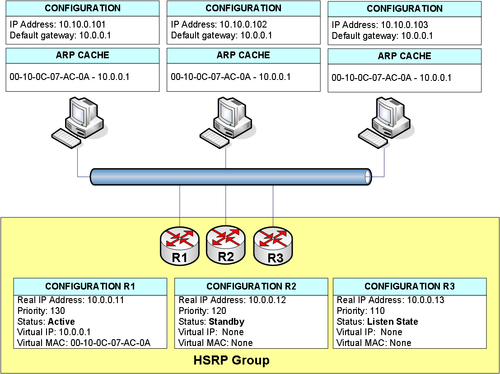Difference between revisions of "Hot Standby Router Protocol"
m |
m (→Configuration of R1, R2 and R3) |
||
| Line 30: | Line 30: | ||
interface FastEthernet1/0 | interface FastEthernet1/0 | ||
ip address 10.0.0.11 255.0.0.0 | ip address 10.0.0.11 255.0.0.0 | ||
| − | standby priority 130 | + | standby 1 priority 130 |
| − | standby preempt | + | standby 1 preempt |
| − | standby ip 10.0.0.1 | + | standby 1 ip 10.0.0.1 |
</pre> | </pre> | ||
| | | | ||
| Line 40: | Line 40: | ||
interface FastEthernet1/0 | interface FastEthernet1/0 | ||
ip address 10.0.0.12 255.0.0.0 | ip address 10.0.0.12 255.0.0.0 | ||
| − | standby priority 120 | + | standby 1 priority 120 |
| − | standby preempt | + | standby 1 preempt |
| − | standby ip 10.0.0.1 | + | standby 1 ip 10.0.0.1 |
</pre> | </pre> | ||
| | | | ||
| Line 50: | Line 50: | ||
interface FastEthernet1/0 | interface FastEthernet1/0 | ||
ip address 10.0.0.13 255.0.0.0 | ip address 10.0.0.13 255.0.0.0 | ||
| − | standby priority 110 | + | standby 1 priority 110 |
| − | standby preempt | + | standby 1 preempt |
| − | standby ip 10.0.0.1 | + | standby 1 ip 10.0.0.1 |
</pre> | </pre> | ||
|} | |} | ||
[[Category:Cisco]][[Category:CCNP]][[Category:IOS]][[Category:Network]][[Category:CCNP3]] | [[Category:Cisco]][[Category:CCNP]][[Category:IOS]][[Category:Network]][[Category:CCNP3]] | ||
Revision as of 09:52, 3 May 2009
HSRP or Hot Standby Router Protocol is a protocol defined by Cisco and now described in rfc2281.
Contents
Purpose of HSRP
The purpose of HSRP is to ensure network connectivity in case of Router or access circuit failure, by having one or more standby Router(s) waiting to take over from the failing active Router.
Other high availability Router protocols
How does HSRP workHSRP works by two or more Routers agreeing upon which Router serves the virtual Router. The Virtual RouterThe Virtual Router is a MAC-address and a IP Address the active Router serves beside its configured IP address. If the active Router fails one of the standby Routers becomes the Virtual Router by serving the virtual MAC-address and IP Address. HSRP exampleIn picture 1 three Routers R1,R2 and R3 are setup in a HSRP Group. The Virtual IP address 10.0.0.1 and virtual MAC-Address 00-10-0C-07-AC-0A are served by the active Router R1. R1 continuesly transmits hello packets to the standby Routers. |
Configuration of R1, R2 and R3
hostname R1 ! interface FastEthernet1/0 ip address 10.0.0.11 255.0.0.0 standby 1 priority 130 standby 1 preempt standby 1 ip 10.0.0.1 |
hostname R2 ! interface FastEthernet1/0 ip address 10.0.0.12 255.0.0.0 standby 1 priority 120 standby 1 preempt standby 1 ip 10.0.0.1 |
hostname R3 ! interface FastEthernet1/0 ip address 10.0.0.13 255.0.0.0 standby 1 priority 110 standby 1 preempt standby 1 ip 10.0.0.1 |
